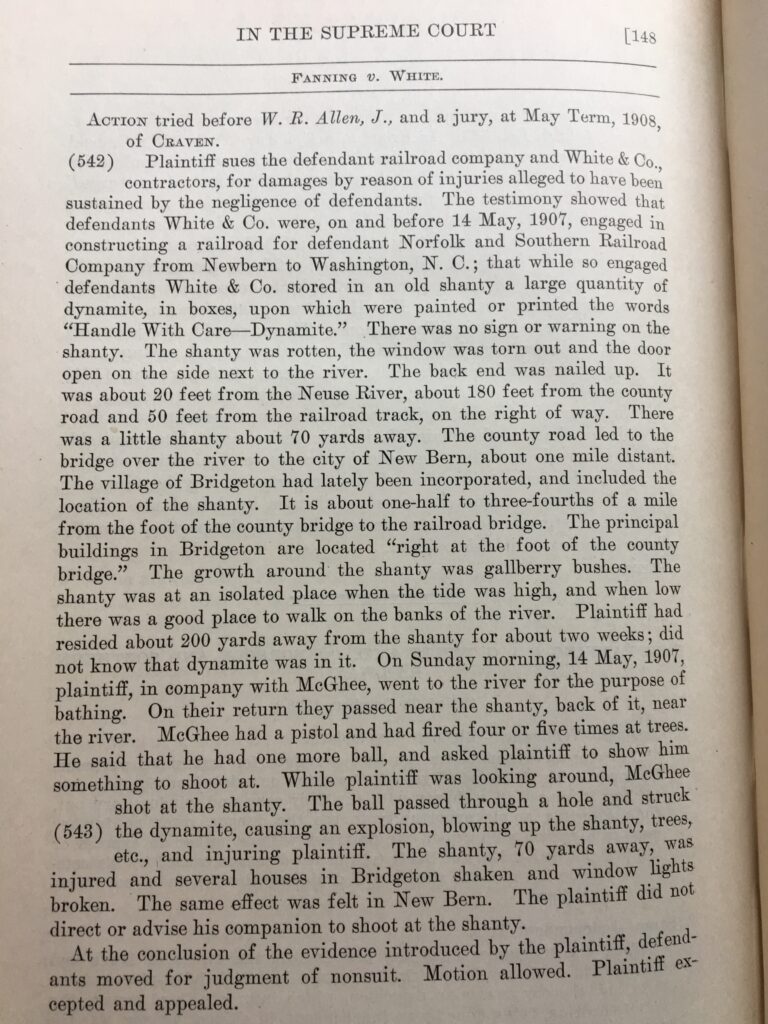
I’m a big baseball fan. (A Pittsburgh Pirates fan, if you’re wondering.) And so of course I stayed up late last night to watch what turned out to be a thrilling end to an historic World Series. I hate to spoil things for those of you who get all your news—legal and otherwise—from this blog, but the Cubs won.
It was, as many of you know, the Cubs’ first championship since 1908. That long title drought prompted lots of stories about what was going on the last time the Cubs could call themselves champs—like, Taft was elected president (by men alone, because women wouldn’t be allowed to vote for more than a decade). And there were only 46 states. And radio as we know it hadn’t yet been invented.
 As it happens, right outside my office is a hallway alcove that includes a set of the North Carolina Reports back to 1907. (Lesser known fact: the Cubs won that year, too.) So there it was: the assembled jurisprudence of our state high court since the North Siders won it all.
As it happens, right outside my office is a hallway alcove that includes a set of the North Carolina Reports back to 1907. (Lesser known fact: the Cubs won that year, too.) So there it was: the assembled jurisprudence of our state high court since the North Siders won it all.
It got me to thinking: what sorts of things was the supreme court deciding back in the fall of 1908? (That was 57 years before the North Carolina Court of Appeals was created, by the way.) So I pulled the volumes for that next-to-oldest year in the set and took a look.
Among the first half-dozen cases:
- An action for crop damages in a railroad right-of-way in Tyrrell County.
- A chattel mortgage on a mule and cart in Bertie.
- An action to enjoin the cutting and removing of a tree in Craven.
You immediately get a window into what felt like a simpler time. Flipping through the remainder of the term, one type of case clearly predominates: property damage and personal injury caused by trains. For the entire fall term, I counted over 25 cases where a railroad company was the defendant for one type of negligence or another.
Forgive the digression, but I have to spend a minute or two on one of those cases, Fanning v. White and Norfolk and Southern Railway, 148 N.C. 541 (1908). The case stemmed from an incident involving “a large quantity of dynamite, in boxes, upon which were painted or printed the words ‘Handle With Care—Dynamite,'” stored in a “shanty” in a railroad right of way. The opinion itself describes the incident well:
On Sunday morning . . . plaintiff, in company with McGhee, went to the river for the purpose of bathing. On their return they passed near the shanty, back of it, near the river. McGhee had a pistol and had fired four or five times at trees. He said that he had one more ball, and asked plantiff to show him something to shoot at. While plaintiff was looking around, McGhee shot at the shanty. The ball passed through a hole and struck the dynamite, causing an explosion, blowing up the shanty, trees, etc., and injuring plaintiff. The shanty, 70 yards away, was injured and several houses in Bridgeton shaken and window lights broken. The same effect was felt in New Bern.
If the case sounds familiar to some of you, it may be because it shares a lot of details with the backstory of Big Thunder Mountain Railroad roller coaster at Disney World.
Turning to the criminal cases considered in the term, we again get a sense of a largely rural, agricultural state.
- State v. Wilkes, a charge of willful abandonment of crops.
- State v. Dixon, a break-in at a smokehouse.
- State v. Thomas, a charge for building a barbed wire fence within 10 yards of public road without the requisite plank on top.
There are several cases involving the sale of intoxicating liquors and one involving a charge of disturbing a worship service. The railroads show up in the criminal cases, too, with two appeals of charges for running freight on a Sunday.
There were, of course, some cases involving very serious charges, too. I counted five murder cases, two manslaughter cases, one rape, and a burglary. In two of those cases the defendant raised an insanity defense. I’m not sure of the precise crime at issue in State v. Moses, because the full opinion reads: “It appearing that defendant has broken jail and is still at large, the appeal is dismissed.” I hope justice was served.
So congratulations Cubs fans! A lot has changed in the world—and in North Carolina’s courts—since you last wore the crown. The stories of your devotion (did you see the one about my School of Government colleague Brian Newport on espn.com?) and, now, celebration make me happy. But if I’m being honest, these are half-hearted congratulations at best. Seeing as almost every player on your team is like 23 years old and under a team-favorable contract, I fear my Pirates may be looking up at you in the standings for a while. For now, I’ll do what I do at the end of each season: read The Green Fields of the Mind to my little leaguer sons, and start our countdown to when pitchers and catchers report.
